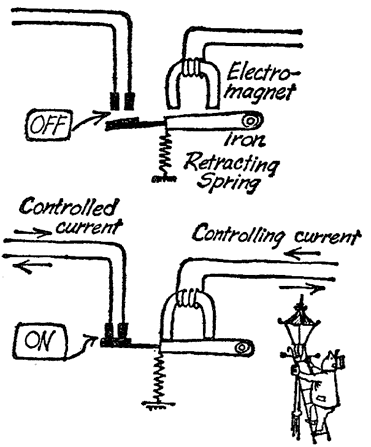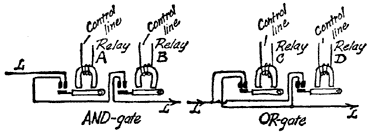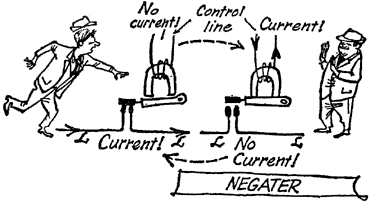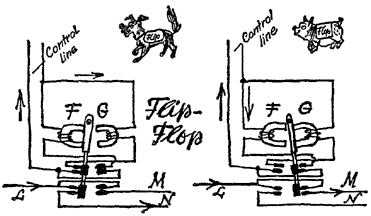Gates and Flip-Flops
Unlike the switches for the bedside lamp and the staircase, nothing is switched on or off by hand in an electronic computer. The electric current itself takes care of the switching procedure. It frequently happens In electrical engineering that current is switched by means of current. The process is carried out in several different ways, for example by a "relay," as in Illus. 8.

Illus. 8
A relay consists of an electromagnet which is magnetized only when an energizing or "controlling" current is supplied to it. It then attracts a piece of iron suspended in front of it, and contact with the piece of iron switches on another current, a "controlled current."
If the controlling current is removed from the magnet, it releases the iron, and a spring pulls back the switch for the controlled current to the "off" position.
Street lights, for instance, are switched on and off in this way. There is a little switch on the desk of the city's Chief Lighter-Up. Wires lead from it to relays in different districts. The little switch on the desk "actuates" the relays, by sending a very little current through to the magnets, and these in due course turn on the mighty switches for many thousands of city lamps.

Illus. 9
We have shown in Illus. 9 how you can construct an and-gate and an or-gate with relays.
In the case of the and-gate, a controlling current must be sent through both relays A and B, so that current can flow through lead L. In an or-gate it is sufficient, if C or D has controlling current, to allow the controlled current to pass through L.
But how about the negater? Here, the switch for the controlled current is quite simply to be found on the other side of the piece of iron: If the relay receives controlling current, the current in L is interrupted. If there is no controlling current, the switch closes and current flows through L.

Illus. 10
The flip-flop is more complicated. Probably only more advanced students will be able to follow its workings. Nevertheless, we are supplying two drawings of it.

Illus. 11
Magnet F has just been in action in the drawing on the left. The controlled current now flows from L to N. If a fresh impulse of current comes over the control line - "flip!" - magnet G responds. The flip-flop switches over (from the drawing on the left to the drawing on the right). The controlled current has now been detoured to M. Flop! A new impulse over the control line, and the state of affairs shown in the drawing on the left is restored: the controlled current flows once more towards N.
©
by PhiloPhax & Lauftext
& Redaktion Lohberg
Kybernetik
- Was ist das?
First printed in Germany: 1963